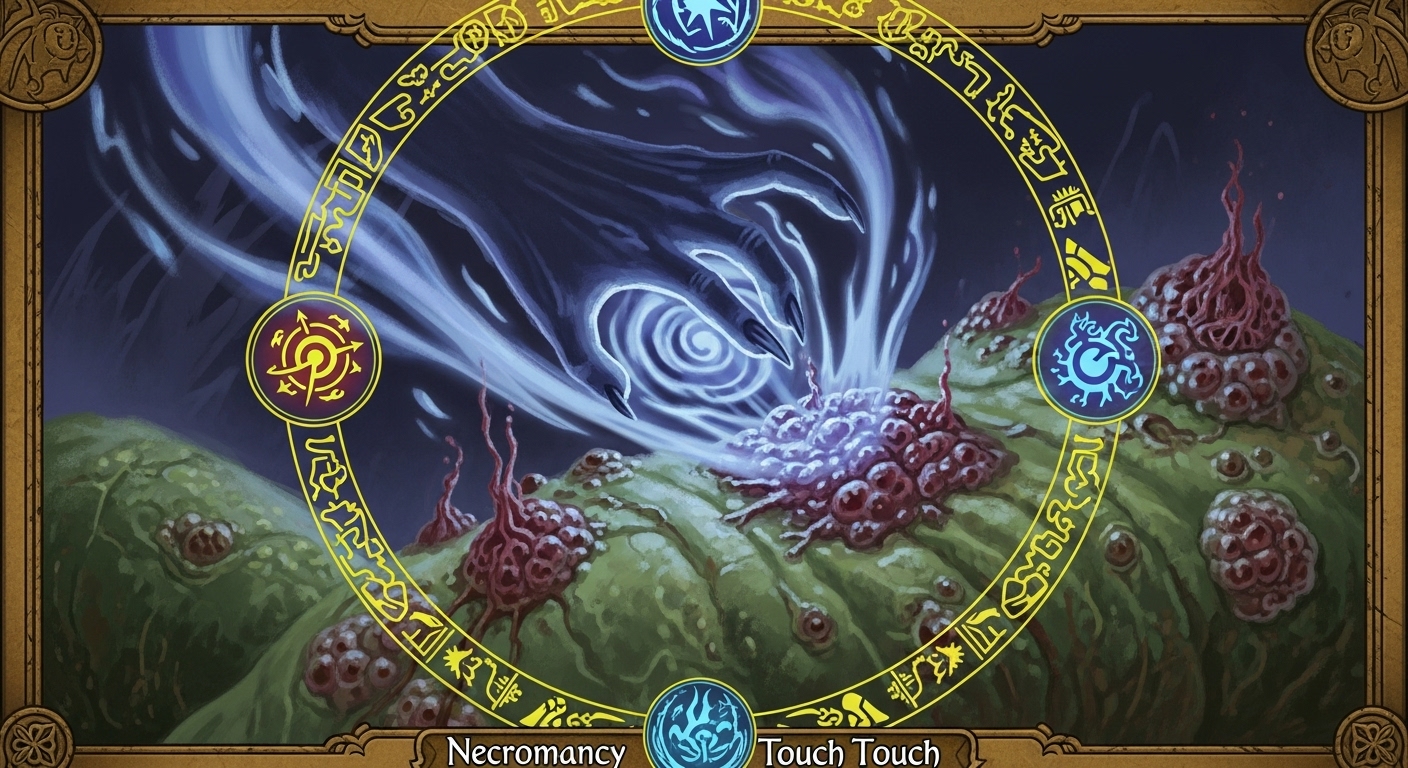Contagion

- Level: 5
- School: Necromancy
- Class: Cleric, Druid
- Casting Time: Action
- Range: Touch
- Components: V, S
- Duration: 7 days
Your touch inflicts a magical contagion. The target must succeed on a Constitution saving throw or take 11d8 Necrotic damage and have the Poisoned condition. Also, choose one ability when you cast the spell. While Poisoned, the target has Disadvantage on saving throws made with the chosen ability.
The target must repeat the saving throw at the end of each of its turns until it gets three successes or failures. If the target succeeds on three of these saves, the spell ends on the target. If the target fails three of the saves, the spell lasts for 7 days on it.
Whenever the Poisoned target receives an effect that would end the Poisoned condition, the target must succeed on a Constitution saving throw, or the Poisoned condition doesn't end on it.
Tactical Usage
Persistent Debilitation: Contagion creates a powerful ongoing effect that can severely weaken enemies over time. This 5th-level necromancy spell excels at eliminating key targets through persistent disadvantage and damage.
Optimal Timing: Most effective against single high-value targets who rely on the chosen ability. The touch range requires careful positioning or setup.
Resource Management: Uses a 5th-level spell slot - available from character level 9+. High damage and persistent effects justify the significant resource investment.
Target Selection: Choose ability based on enemy strengths - Dexterity for rogues, Wisdom for spellcasters, Constitution for tanks.
Spell Combinations
Synergistic Spells:
- Touch Delivery: Use reach spells or movement to safely deliver touch attacks
- Ability Targeting: Combine with effects that target the same ability for cumulative penalties
- Condition Synergy: Layer additional poisoned effects for overwhelming debilitation
Class Feature Interactions:
- Spell Attack Bonuses: Features that improve touch attack reliability
- Touch Spell Delivery: Familiar or spiritual weapon can potentially deliver touch spells
- Disease Resistance: Some cleric domains provide thematic bonuses to disease effects
Multi-Caster Coordination: Multiple contagion effects can target different abilities for comprehensive weakening.
Material Component Details
Component Acquisition: No material components required - only verbal and somatic components needed.
Component Handling: Simple V, S casting, though touch range creates tactical considerations.
Roleplay Opportunities: The necromantic nature and disease theme provide dark magical atmosphere.
Economic Considerations: No costs make this spell economically viable despite the high spell slot requirement.
Creator Notes
Encounter Balancing: Potentially eliminates major enemies over several rounds. Consider how persistent debilitation affects encounter difficulty.
NPC Usage: Enemy clerics or druids can use this to weaken party leaders, creating ongoing tactical challenges.
Environmental Considerations: Disease-themed encounters become more atmospheric. Some environments might enhance or resist disease magic.
Campaign Integration: Excellent for horror campaigns, plague scenarios, or encounters involving disease and decay themes.
Environmental Interactions
Terrain Effects: Touch range requires close positioning. Difficult terrain affects approach opportunities.
Weather Influence: No direct mechanical effects, though disease themes might interact with environmental conditions.
Structural Interactions: Touch requirement means positioning and cover become crucial tactical considerations.
Elemental Interactions: Necrotic damage interacts with undead immunity/resistance. Life energy areas might oppose disease magic.
Common Rulings & Clarifications
Timing Questions: Initial save determines immediate damage and poisoning. Three successes or failures determine final duration.
Target Limitations: Touch range requires successful spell attack or willing target. Effects self-terminate after resolution.
Duration Interactions: Seven-day duration if three failures occur. Condition removal requires Constitution saves to resist.
Mechanical Interactions: Chosen ability suffers disadvantage on saves while poisoned. Anti-poison effects must overcome spell resistance.
Alternative Applications
Non-Combat Uses: Interrogation through threatened disease, though ethical considerations make this rarely appropriate.
Social Encounters: Demonstrate necromantic power, though diseasing people typically escalates rather than resolves conflicts.
Exploration Applications: Weaken dangerous creatures before encounters, though touch range limits practical application.
Utility Functions: Limited utility applications due to harmful nature and touch requirement.
Related Spells
Same School: Other necromancy spells like blight (4th level plant damage), harm (6th level major damage), finger of death (7th level instant death).
Similar Effects: bestow curse (3rd level ability penalties), harm (6th level immediate damage), poison effects of various levels.
Progression Options: inflict wounds (1st level touch damage), bestow curse (3rd level ability penalties), harm (6th level massive damage).
Complementary Magic: hold person (guarantee touch delivery), spiritual weapon (potential touch delivery), greater restoration (cure diseases).
Scaling Analysis
Level Progression: Significant impact spell that remains threatening throughout high-level play due to ability penalties and duration.
Upcast Benefits: No improvement from higher spell slots, making this a pure 5th-level investment with high impact.
Campaign Phases: Peak effectiveness in mid-to-high level play where ability penalties create major tactical disadvantages.
Comparative Value: High-impact single-target spell that can effectively remove enemies from combat over time.
Narrative Flavor
Casting Description: Necromantic energy flows through your touch as magical disease takes hold, spreading corruption through the target's body.
Effect Manifestation: The target visibly weakens as the magical contagion spreads, creating visible signs of disease and systemic breakdown.
Personal Style: Death domain clerics might channel plague energy, while druids manifest natural disease processes, both with appropriate thematic elements.
World Integration: Represents powerful necromancy that creates magical diseases, often associated with plague magic, corruption, or divine punishment for transgressions.